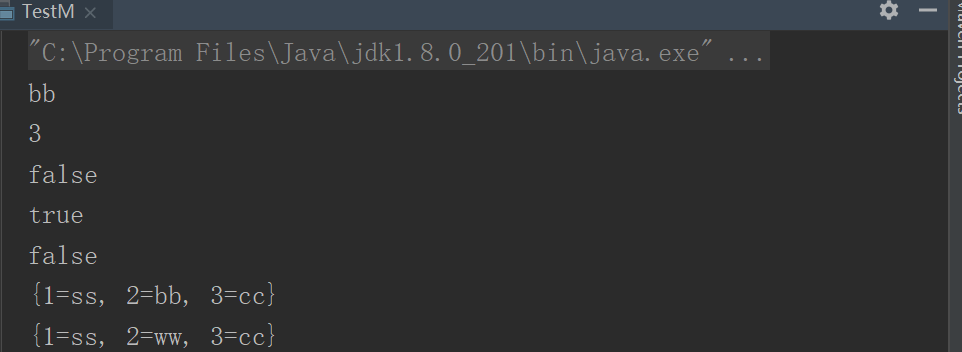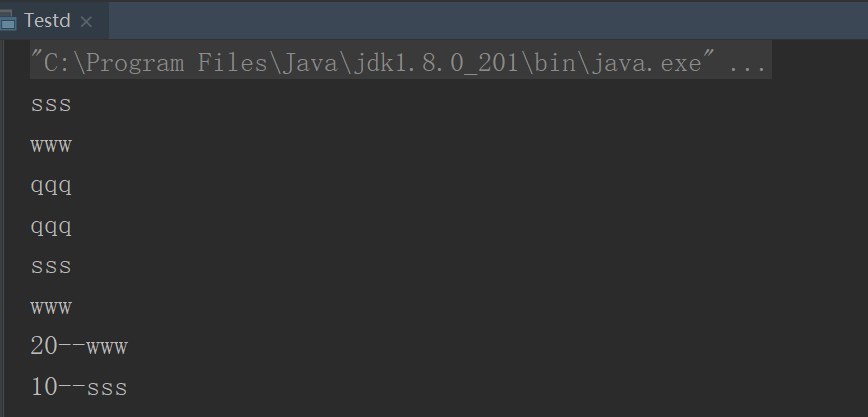Map interface
Classes that implement the Map interface are used to store key-value pairs.
The implementation classes of Map interface include HashMap and TreeMap.
Key-value pairs stored in Map classes are identified by keys, so key values (as indexes) cannot be repeated (if two objects equals each other, their hashCode s must be the same), and if repeated, the contents corresponding to the same key value will be overwritten.
The corresponding usage is as follows:
public class TestM {
public static void main(String[] args) {
Map<Integer,String> m=new HashMap<>();
m.put(1,"aa");//Deposit
m.put(2,"bb");
m.put(3,"cc");
System.out.println(m.get(2));//take out
System.out.println(m.size());
System.out.println(m.isEmpty());
System.out.println(m.containsKey(1));
System.out.println(m.containsValue("dd"));
Map<Integer,String> m1=new HashMap<>();
m1.put(1,"ss");
m.putAll(m1);
System.out.println(m);
//Keys cannot be repeated
m.put(2,"ww");
System.out.println(m);
}
}

public class TestM1 {
public static void main(String[] args) {
People p1=new People(123,"tom",3000);
People p2=new People(133,"jerry",3500);
People p3=new People(143,"tim",4000);
Map<Integer,People> m=new HashMap<>();
m.put(123,p1);
m.put(133,p2);
m.put(143,p3);
People pe=m.get(123);
System.out.println(pe.getName());
System.out.println(pe);
}
}
class People{
private int id;
private String name;
private double salary;
public People (int id,String name,double salary){
super();
this.id=id;
this.name=name;
this.salary=salary;
}
@Override
public String toString(){
return "id:"+id+"name:"+name+"salary"+salary;
}
public void setId(int id) {
this.id = id;
}
public void setName(String name) {
this.name = name;
}
public void setSalary(double salary) {
this.salary = salary;
}
public int getId() {
return id;
}
public String getName() {
return name;
}
public double getSalary() {
return salary;
}
}

iterator
Overview: Help us do set traversal tools.
What it does: There are many collections in java that use different storage methods when storing elements. So when we want to extract elements from these sets, we can do it in a general way.
Traverse list, set, map with iterator:
public class Testd {
public static void main(String[] args) {
test();
testset();
testmap();
}
public static void test(){
List<String> list=new ArrayList<>();
list.add("sss");
list.add("www");
list.add("qqq");
//Traversal using iterators
for (Iterator<String> it = list.iterator(); ((Iterator) it).hasNext();){
Object t= ((Iterator) it).next();
System.out.println(t);
}
}
public static void testset(){
Set<String> set = new HashSet<>();
set.add("sss");
set.add("www");
set.add("qqq");
//Traversal using iterators
for (Iterator<String> it = set.iterator(); ((Iterator) it).hasNext(); ) {
Object t = ((Iterator) it).next();
System.out.println(t);
}
}
public static void testmap() {
Map<Integer,String> map = new HashMap<>();
map.put(10,"sss");
map.put(20,"www");
map.put(30,"eee");
//Traversal using iterators
Set<Map.Entry<Integer,String>> ss=map.entrySet();
for(Iterator<Map.Entry<Integer,String>>it=ss.iterator();it.hasNext();){
Map.Entry<Integer,String> t=it.next();
System.out.println(t.getKey()+"--"+t.getValue());
}
}
}
